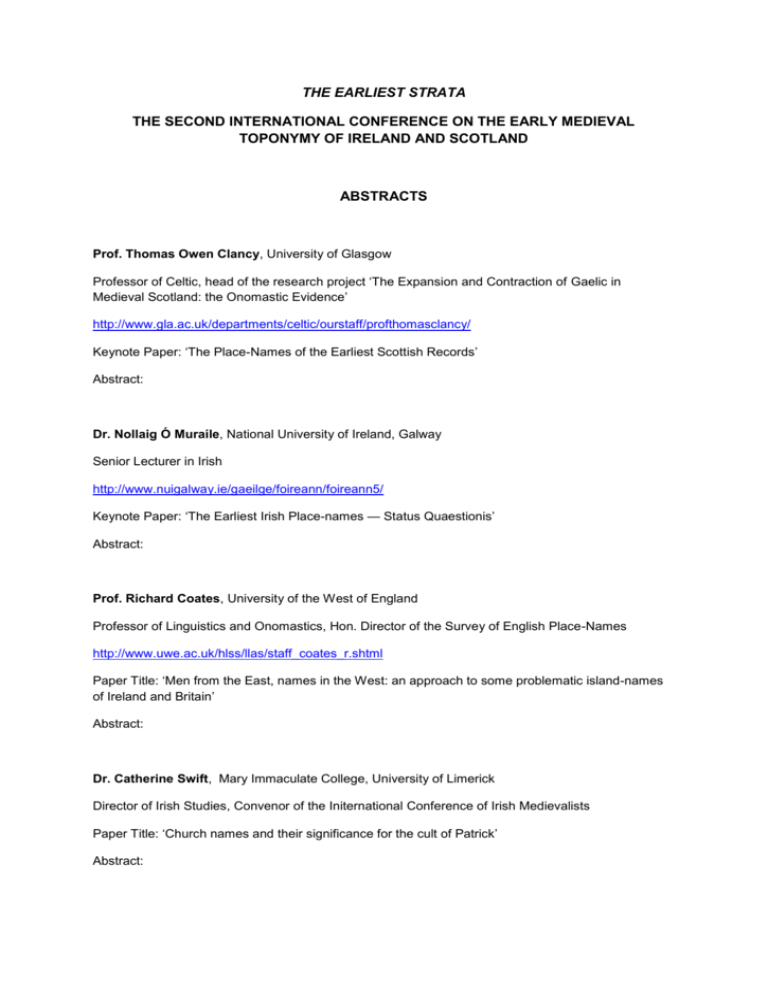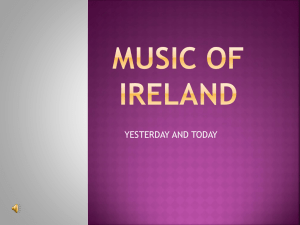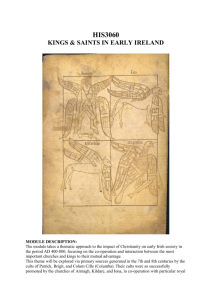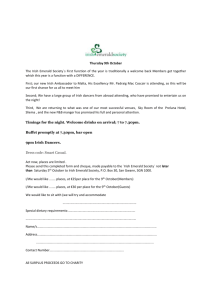Abstracts - Queen`s University Belfast
advertisement

THE EARLIEST STRATA THE SECOND INTERNATIONAL CONFERENCE ON THE EARLY MEDIEVAL TOPONYMY OF IRELAND AND SCOTLAND ABSTRACTS Prof. Thomas Owen Clancy, University of Glasgow Professor of Celtic, head of the research project ‘The Expansion and Contraction of Gaelic in Medieval Scotland: the Onomastic Evidence’ http://www.gla.ac.uk/departments/celtic/ourstaff/profthomasclancy/ Keynote Paper: ‘The Place-Names of the Earliest Scottish Records’ Abstract: Dr. Nollaig Ó Muraíle, National University of Ireland, Galway Senior Lecturer in Irish http://www.nuigalway.ie/gaeilge/foireann/foireann5/ Keynote Paper: ‘The Earliest Irish Place-names — Status Quaestionis’ Abstract: Prof. Richard Coates, University of the West of England Professor of Linguistics and Onomastics, Hon. Director of the Survey of English Place-Names http://www.uwe.ac.uk/hlss/llas/staff_coates_r.shtml Paper Title: ‘Men from the East, names in the West: an approach to some problematic island-names of Ireland and Britain’ Abstract: Dr. Catherine Swift, Mary Immaculate College, University of Limerick Director of Irish Studies, Convenor of the Initernational Conference of Irish Medievalists Paper Title: ‘Church names and their significance for the cult of Patrick’ Abstract: Dr. Grigory Bondarenko, University of Ulster Research Fellow, Assistant Editor of the eDIL Project http://www.dil.ie/Grigoriy Bondarenko.asp Paper Title: ‘Goidelic hydronyms in Ptolemy’s Geography: Myth behind the name’ Abstract: The author highlights some comparisons between Goidelic hydronyms as preserved by an ancient Greek geographer of the second century AD Claudius Ptolemaeus and in early Irish placelore. This approach consequently helps to illustrate the mytho-toponymic tradition of early medieval Irish narratives in a deeper time frame. Goidelic place names preserved in Ptolemy together with Gaulish epigraphy combined can support our analysis of the mythological motifs in early medieval Irish prose and poetry (even when the underlying semantics had changed through time). This analysis on a linguistic level seems to show certain continuity in religious and mythological worldview from Continental Celts to the early Irish before the adoption of Christianity. This comparative approach offered in the paper may form a contribution to the problem of links and influences between GraecoRoman and Celtic civilisation. Dr. Richard Warner, Keeper of Antiquities (Retired), Ulster Museum Paper Title: ‘Ptolemy's Ireland - observations from an archaeologist’ Abstract: This paper will look at Ptolemy's Irish geography from the point of view of an archaeologist. Some critical comments will be made regarding previous work on this topic, and new identifications will be proposed for some places. Dr. Jacob King, Ainmean-Àite na h-Alba Paper Title: ‘A lost Aber- name in Speyside’ Abstract: Dr. Richard Cox, Sabhal Mòr Ostaig (University of the Highlands and Islands) Paper Title: ‘The Etymology of Gaoitbheinn, Isle of Arran’ Abstract: Scots/English Goatfell, Scottish (Arran) Gaelic Gaoitbheinn and Gaoth Bheinn all denote Arran’s highest mountain, which rises to 874m in the north-eastern quarter of the island. This paper will look at these different naming traditions, the historical phonology of the forms associated with them and at the relationship between them. In short, the evidence suggests that, via a series of phonological adaptations and morphemic substitutions, PSc Gait-fjall ‘goat-mountain’ developed into EG *Gaítbeál (a borrowing datable to some time before the 11th century), so early modern ScG *Gaoidbhal and subsequently modern Arran Gaelic Gaoitbheinn – now short Găŏitbheinn. Meanwhile, earlier ScG *Gaoidbhal developed into Scots/Eng. Goatfell and, later, through folk etymology, into ScG Gaoth Bheinn, resulting in a separate Scottish Gaelic tradition. Dr. Emma Nic Cárthaigh, University College Cork Lecturer, working until recently as a research student on the Locus Project. Now carrying out postdoctoral research on the De Finibus Project. http://www.ucc.ie/acad/smg/Emma.htm Thesis: ‘Staidéar stairiúil ar áitainmneacha na Gaeilge dar tosach ‘D’, bunaithe ar fhoinsí SeanGhaeilge, Meán-Ghaeilge, Nua-Ghaeilge Moiche agus ar fhoinsí Laidin na hÉireann: Dá Ailt Déag – Doirín Cranncha’ (An historical study of Gaelic placenames beginning with the letter ‘D’, based on Old-Irish, Middle-Irish, Early Modern Irish and Irish Latin sources: Dá Ailt Déag – Doirín Cranncha) Paper Title: 'Difficulties determining early medieval Irish tribal boundaries: Dál, Dealbhna, Dartraighe' Abstract: Early medieval Irish tribal boundaries often pose difficulties for those trying to determine their extents. The regions in question may be sizeable and the textual evidence concerning them was generally only compiled long after the tribal boundaries had lost their significance as borders between peoples. In spite of this, many references to these tribal groups and their territories survive and, in many cases, it is possible to postulate the extent of the relevant lands from this textual evidence. Tribes named with the generic element ‘Dál’ prove particularly difficult to locate and there is often confusion between discrete groups. This paper will outline the difficulties separating the strands of evidence relating to Dál Buain and Dál Buinne in order to locate these two groups and will postulate locations for them. Similiarly, problems arise in the case of Dealbhna, Dealbhna Mhór and Dealbhna Bheag. These problems will be outlined and discussed and a possible location for the elusive Dealbhna Bheag will be proposed. Finally, whereas Dartraighe is not as problematic as the latter examples, difficulties arise when trying to parse the evidence for what is two distinct groups. These difficulties will also be outlined and possible conclusions put forward. Kelly Kilpatrick, Wadham College, University of Oxford Research Student Thesis: The historical interpretation of early medieval insular place-names Paper Title: ‘Place-names in a Hagiographic Tradition of St Brigit of Kildare: Analysis of Vita Prima and Bethu Brigte’ Abstract: Two early Lives of St Brigit of Kildare, the Latin Vita Prima and the vernacular Bethu Brigte, preserve a significant number of territorial-names and place-names (most of which are identifiable). This provides the opportunity to investigate the places of early cult-sites dedicated to St Brigit, most of which also belonged to Kildare’s paruchia. In Vita I and Bethu Brigte, Brigit is demonstrated to be an itinerant saint, and through the place-names recorded she is promoted as a saint worthy of national beatification. The possible interpretations of these place-names in this tradition are often a subject of debate in modern scholarship, largely due to a possible political ambition underlying their inclusion in the texts. Regardless of this, the toponymic corpus in these Lives implies a network of common devotion to St Brigit throughout many provinces in early medieval Ireland. In comparison with later sources, it will be observed that Brigit had cult-sites dedicated to her in nearly every region she was said to have travelled in Vita I and Bethu Brigte, which implies that Brigit had a strong and enduring cult in these areas. There are many reasons for this, but a notable cause lies in the fact that Brigit’s paternal kin, the Fothairt, dwelled in many of these regions. In areas where dedications to St Brigit were particularly strong, she also became incorporated into the local landscape, where significant natural and man-made features became associated with her; early examples of this can be found in both Vita I and Bethu Brigte. Peter McNiven, University of Glasgow Research Student, working on the research project ‘The Expansion and Contraction of Gaelic in Medieval Scotland: the Onomastic Evidence’ Thesis: ‘Gaelic place-names and the social history of Gaelic speakers in Menteith before 1300’. Further information at http://www.gla.ac.uk/departments/celtic/postgraduatestudy/currentstudentresearch/ Paper Title: ‘P-Celtic place-names in Menteith: British or Pictish?’ Abstract: Liam Ó hAisibéil, National University of Ireland, Galway Research Student Thesis: ‘Logainmneacha Chontae Ros Comáin: Ainmneacha na mbailte fearainn’ (Place-Names of Co. Roscommon: Townland Names). Further information at http://www.nuigalway.ie/gaeilge/taighde/ Paper Title: ‘The Boldly Odd Hills of Northern Roscommon’ Abstract: Aengus Finnegan, National University of Ireland, Galway Research Student Thesis: ‘Logainmneacha Chill Chainnigh Thiar agus Chluain Lonáin – Ainmneacha na mBailte Fearainn’ (The Placenames of Kilkenny West and Clonlonan (Co. Westmeath) - The Townland Names). Further information at http://www.nuigalway.ie/gaeilge/taighde/ Paper Title: ‘The Topography of Bruidhean Da Choga or Bryanmore Hill' Abstract: The Townland of Bryanmore Upper, in the Barony of Kilkenny West, Co. Westmeath is one subdivision of the former ballybetagh (baile biataigh) of Bruidhean Da Choga, the others being the adjacent townlands of Bryanmore Lower, Bryanbeg Upper and Bryanbeg Lower. Bruidhean Da Choga features in a famous medieval Irish tale called Togail Bruidne Da Choca; ‘The destruction of Da Choga’s hostel’ The principal topographical feature of the townland is the prominent furze-covered Bryanmore Hill (123m). On the south-western slope of the hill the remains of Bruíon Da Choga are to be found. Bruíon, (or in earlier Irish orthography; Bruidhean) usually signifies a hostel, or a large fairy dwelling. The extended landscape surrounding the hill contains a number of features which can be tentatively connected to the text, as well as a number of townlands which are mentioned in the text. This paper will explore theses traces in the landscape. Guto Rhys, University of Glasgow Research Student Thesis: ‘P-Celtic in Northern Britain, the Evidence of Place-names’. Further information at http://www.gla.ac.uk/departments/celtic/postgraduatestudy/currentstudentresearch/ Paper Title: ‘Towards a phonology of “Pictish”’ Abstract: Guto Rhys is working on a PhD at Glasgow university, investigating the evidence for the linguistic nature of later (post syncope & apocope) P-Celtic in northern Britain - the variants often referred to as (Northern) Brittonic/Brythonic/Cumbric and also Pictish. The aim is to collate the evidence, primarily from secondary sources, and to examine the reflexes of each phonetic segment in order to approach issues of separate development and similarities. The work involves general research into Brittonic toponymy, manuscript transmission and the mediation of successor languages. The presentation will outline and compare the reflexes of the segments of the Brittonic phonetic system c.600 in both of the above-mentioned variants. Stephen Digney, University of Glasgow Research Student Thesis: ‘Early Medieval Settlement, Routeways, and Contacts in the Forth Valley: a focus on the Church’. Further information at http://www.gla.ac.uk/departments/celtic/postgraduatestudy/currentstudentresearch/ Paper Title: ‘Iudeu and Stirling: a possible example of place name change’ Abstract: Stirling appears in the historic record of the 12th century as one of the strongest and most strategic royal castles in Scotland, yet it is a name not found in any first millennium source. This contrast between the apparent absence of Stirling in the first millennium and its prominence in the next led Graham (1959) to suggest that the British named fortress, urbs Iudeu (Bede’s urbs Giudi), ‘should fill the blank’. This identification held the field until Fraser’s (2008) recent challenge encouraged a reconsideration of the evidence and alternative ways of viewing the problem. In response this paper will present a renewed hypothesis for Stirling and discuss the implied place-name change. Paul Tempan, Queen’s University Belfast Research Student Thesis: ‘A study of topographical elements in Irish place-names through observation in the field’. Further information at http://www.qub.ac.uk/schools/SchoolofLanguagesLiteraturesandPerformingArts/PostgraduateResearc handthePostgraduateCommunity/studentprofiles/ Paper Title: ‘Carbad in Irish place-names: chariot or boulder?’ Abstract: Ir. carbad, meaning ‘boulder’, is a word largely overlooked by dictionaries and known primarily from its occurrence in Irish place-names. It appears to have no cognates in other Celtic languages. In Modern Irish it is a homonym of carbad, ‘chariot’ (OIr. carpat), though it is probable that the two words have quite separate etymologies. Some toponymists, notably P.W. Joyce, have preferred the sense ‘chariot’ in the vast majority of place-names containing carbad. This is also the sense typically attributed to such names when they occur in medieval dinnseanchas sources. However, there is a consensus in current place-name scholarship that carbad refers to boulders in certain names. This paper aims to show how observation in the field and topographical analysis can help to ascertain a reliable interpretation and concludes that the sense ‘boulder’ is probably much more common than has heretofore been recognised. Carbad is one of a group of Irish words in car– denoting rock, including carraig, carn, carrach and cairthe/coirthe. Parallels with Continential Celtic names and other Continental European names in kar– + labial extension (karb– / karp– / kar(a)v–) referring to rock features are discussed. It is proposed that carbad can be analysed as carb– ‘rock’ + suffix –ad. The precise meaning of the suffix –ad/–aid is unclear, but it is familiar in other Irish place-name elements such as caolad, dromad, leithead, fánaid.







